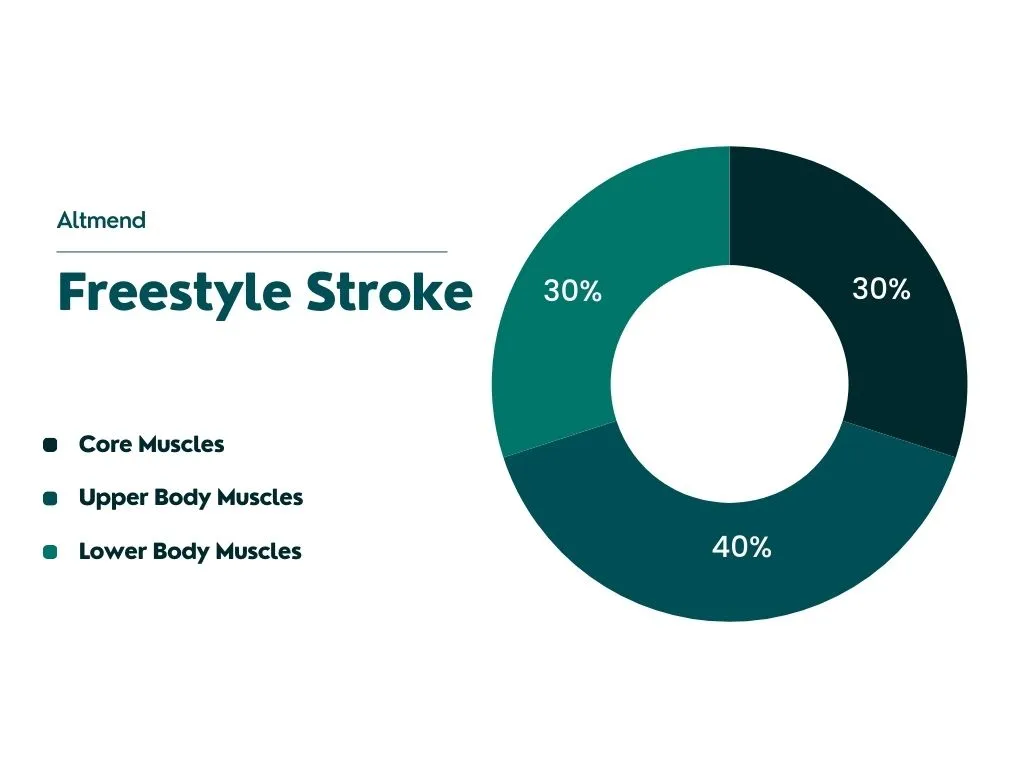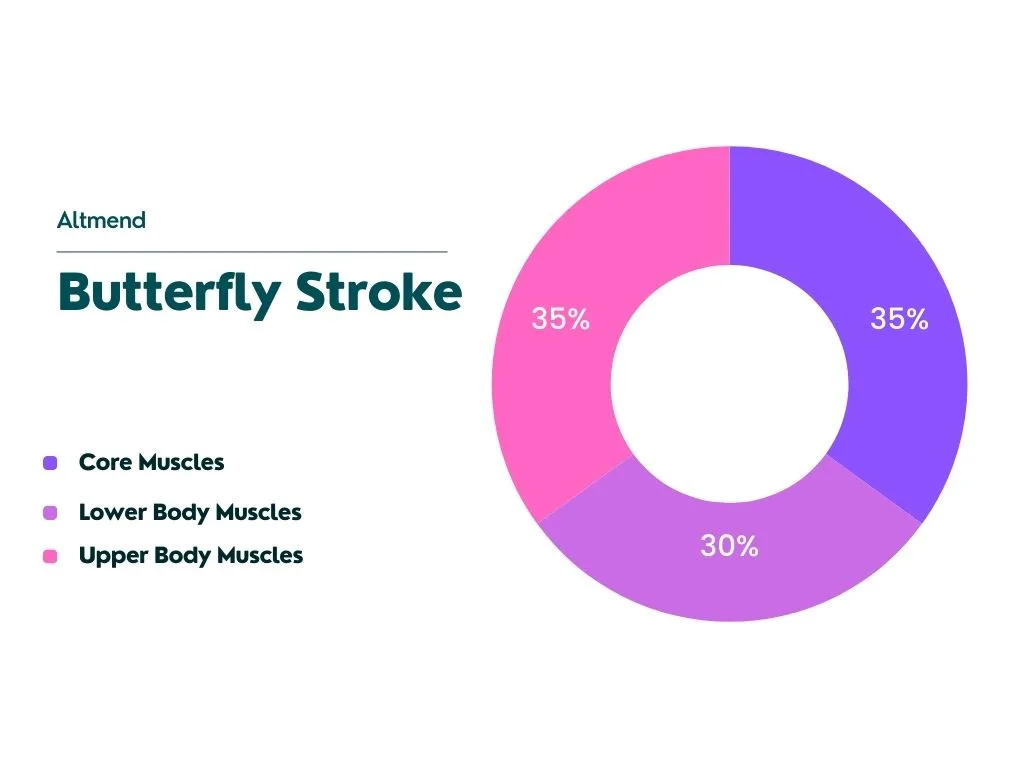Swimming, a sport demanding cardiovascular fitness, technique, and strength, often sees athletes concentrating on endurance and form. However, integrating strength training into a swimmer’s routine can substantially boost their performance.
This article explores the advantages of strength training, delves into its physiological aspects, introduces diverse training approaches, and offers guidance on progress monitoring. By the end, you’ll recognize the significance of strength training and possess knowledge to elevate your swimming capabilities.
Benefits of Strength Training for Swimmers
Enhanced Propulsion
A robust kick and pull result in increased force against the water, fostering faster swimming. Targeting major muscle groups crucial for swimming through exercises amplifies power output, making water traversal more efficient.
Injury Prevention
Swimming’s repetitive nature stresses muscles and joints, elevating injury risks. Strengthening these areas and enhancing joint stability can minimize injuries, ensuring swimmers stay in peak condition.
Improved Endurance
Endurance is vital for maintaining speed and technique over distances. Strength training enhances muscular endurance, allowing swimmers to sustain strokes and optimize performance during races.
Increased Power and Speed
Crucial for competitive swimming, strength training fosters explosive power, resulting in quicker starts, turns, and sprints. Exercises emphasizing acceleration and power output translate into improved race times.
Better Stroke Technique
Sufficient swimming relies on proper stroke technique. Strength training aids in developing the requisite strength and stability, ensuring optimal stroke mechanics throughout races.
Physiology of Strength Training for Swimmers
Muscle Engagement in Swimming
Swimming Aspects:
| Swimming Aspect | Muscle Group | Role |
|---|---|---|
| Core Engagement | Abdominals, Obliques | Provides stability, maintains streamlined position |
| Upper Body - Pull | Latissimus Dorsi, Rhomboids, Trapezius, Pectorals | Generates force during pulls, essential for strokes |
| Upper Body - Push | Pectorals, Triceps | Facilitates recovery phase, contributes to stroke cycle |
| Lower Body - Kick | Quadriceps, Hamstrings, Glutes | Drives powerful kicks, essential for propulsion |
| Lower Body - Propulsion | Hip Flexors, Adductors, Calves | Generates force for forward motion, aids in kicking |
———————Scroll ———————-
Swimming engages the core, upper body, and lower body muscles. Core stability ensures a streamlined position, upper body muscles generate force during pulls, and lower body muscles drive propulsion through powerful kicks.
The following pie charts visually break down the approximate percentage of engagement for key muscle groups during various strokes, providing insights into the dynamics of each movement.




Adaptations of Muscles to Strength Training
Strength training induces muscle adaptations such as increased fiber size and enhanced neuromuscular coordination. These adaptations boost force generation, power output, and overall athleticism, aligning with swim-specific movements.
Role of Strength in Different Swimming Strokes
Distinct strokes demand specific muscular engagement. Tailoring strength training to meet these demands optimizes performance. For example, freestyle emphasizes upper body strength, while butterfly requires both upper and lower body power.
Physiology of Strength Training for Swimmers
Dividing the training year into phases optimizes performance and prevents overtraining. Periodization involves planning cycles, prioritizing training aspects, and adjusting intensity and volume for optimal results.
Preparatory, competitive, and transition phases constitute a well-structured annual plan. Each phase has a distinct focus, allowing swimmers to progress gradually, peak at the right time, and recover adequately.
Here is an annual training routine used by one of my friends who is a pro swimmer:
Preparatory Phase (Off-Season):
- Duration: 8-12 weeks
- Focus on general strength and hypertrophy.
- Emphasize compound movements for overall muscle development.
- Include higher volume and moderate intensity.
- Strength Training Frequency: 3-4 times per week.
- Sample Exercises: Squats, deadlifts, bench presses, pull-ups, lunges.
- Cardiovascular Conditioning:
Low-intensity cardio for general fitness. - Recovery Emphasis:
- Adequate sleep and nutrition.
- Active recovery sessions.
Competitive Phase (In-Season):
- Duration: 20-24 weeks
- Shift focus towards sport-specific strength.
- Lower volume, increase intensity for power development.
- Emphasize explosive movements.
- Strength Training Frequency: 2-3 times per week.
- Sample Exercises: Swim-specific resistance exercises (e.g., with resistance bands). Olympic lifts with lighter loads and explosive movements.
- Cardiovascular Conditioning: Incorporate interval training for bursts of intensity.
- Recovery Emphasis: Active recovery strategies after intense swimming sessions.
- Monitoring for signs of overtraining.
Transition Phase (Post-Season):
- Duration: 4-6 weeks
- Reduce overall training volume.
- Maintain some strength work at a lower intensity.
- Focus on flexibility and mobility exercises.
- Strength Training Frequency: 1-2 times per week.
- Sample Exercises: Lighter versions of compound movements. Emphasis on mobility exercises.
- Cardiovascular Conditioning:
Low-impact activities like cycling or brisk walking. - Recovery Emphasis:
Prioritize sleep and nutrition for recovery. - Active recovery sessions with a focus on flexibility.
Specific Strength Focus (Throughout):
- Integrate swim-specific strength exercises
- consistently throughout the year, regardless of phase.
- Sample Exercises:
Swim cord exercises for resistance. Medicine ball throws to mimic explosive swim movements and Stability exercises to enhance core strength. - Frequency: 1-2 times per week.
- Recovery Emphasis: Active recovery after swim-specific strength sessions.
- Addressing specific muscle imbalances.
Macro, Meso, and Microcycles
Macrocycles cover the entire year, mesocycles focus on specific training aspects, and microcycles, spanning a week, provide detailed training breakdowns. Strength training should align with each phase, emphasizing a solid foundation during preparation, maintenance during competition, and reduced volume during transition for recovery.
Key Strength Training Exercises for Swimmers
Core Strengthening
Effective core strengthening is pivotal for swimmers, enhancing stability and contributing to an efficient swimming technique. Exercises such as planks and leg raises meticulously target the abdominal muscles, obliques, and lower back, fostering a well-rounded foundation for improved performance in the water.
Upper Body
To fortify the upper body, swimmers can engage in exercises like lat pulldowns, rows, and shoulder presses. These exercises specifically target the back, shoulder, and arm muscles, augmenting strength and power during the crucial pull phase of swimming strokes.
Lower Body
Elevating kicking power and overall performance involves focusing on the lower body. Squats, lunges, and deadlifts are instrumental in targeting the quadriceps, glutes, and hamstrings. These exercises contribute to a robust lower body foundation, essential for efficient propulsion in the
water.
Specificity in Strength Training
Tailoring Exercises to Swimming Movements
It’s imperative to mimic swimming motions in strength exercises to optimize the transfer of strength gains to swimming performance Tailoring workouts to closely replicate the movements involved in swimming ensures a seamless translation of strength improvements to enhanced aquatic capabilities.
Swim-Specific Resistance Training
Integrating resistance bands or parachutes during swimming sessions introduces additional resistance, thereby enhancing strength and power. This swim-specific resistance training challenges swimmers to exert more force during their strokes, contributing to heightened strength gains.
Simulating Swim Conditions in the Gym
Supplementing traditional swimming with gym workouts that emulate swim conditions is a strategic approach. These exercises focus on building stability, balance, and coordination, directly translating into improved swimming performance.
Training Techniques
High-Intensity Training (HIT)
Simulating race conditions through high-intensity training involves near-maximal effort exercises for short durations, followed by rest. This approach mirrors the demands of competitive swimming, fostering mental and physical stamina development.
Circuit Training
Efficiency in building strength, endurance, and cardiorespiratory fitness is achieved through circuit training. This technique involves performing a series of exercises with minimal rest, targeting multiple muscle groups concurrently.
Functional Training for Swimmers
Enhancing overall athleticism and strength involves focusing on movement patterns through functional training. Exercises that closely mimic swimming motions contribute to improved performance in the water.
Incorporating Plyometrics
Improving power and speed in swimming strokes starts, and turns are achieved through plyometric exercises. Box jumps and medicine ball throws, for instance, introduce quick, explosive movements, benefitting various aspects of a swimmer’s performance.
Recovery and Regeneration
Importance of Recovery in Strength Training
Recognizing the significance of recovery in strength training is crucial. Adequate rest between sessions, incorporating active rest days, engaging in foam rolling, and practicing mobility exercises collectively prevent overtraining, optimizing overall performance.
Nutrition
Supporting strength-building and overall performance necessitates a balanced diet rich in carbohydrates, proteins, and fats. Proper hydration complements nutritional efforts, providing swimmers with the necessary fuel for optimal results.
Sleep and Its Impact on Performance
Quality sleep plays a pivotal role in recovery, muscle repair, and overall performance. Emphasizing sufficient sleep duration and establishing a consistent sleep routine becomes imperative for swimmers seeking optimal strength gains.
Active Recovery Strategies
Incorporating light swimming, gentle stretching, and low-intensity exercises between intense training sessions serves as effective active recovery. These strategies promote blood flow, reduce muscle soreness, and facilitate overall recovery for swimmers.
Common Mistakes to Avoid
Overtraining
Maintaining a delicate balance between volume and intensity, incorporating rest, and attentively listening to the body’s signals are pivotal in preventing overtraining. This approach ensures consistent and optimal progress.
Neglecting Technique
While acknowledging the importance of strength, preserving proper technique is equally vital. Swimmers must prioritize maintaining good form during strength exercises to ensure gains translate into improved swimming performance.
Inadequate Warm-up and Cool-down
An essential component of a comprehensive training routine involves a well-structured warm-up and cool-down. Dynamic stretches, mobility exercises, and a progressive warm-up routine prepare the body for strength sessions, while static stretching and foam rolling aid in preventing injuries.
Ignoring Flexibility and Mobility
Incorporating regular stretching and mobility exercises is paramount for swimmers. Neglecting these aspects can limit a swimmer’s range of motion, potentially hindering overall performance. Prioritizing flexibility contributes to enhanced swimming capabilities.
Monitoring Progress
Tracking Strength Gains
A systematic approach to tracking strength gains involves recording details such as weight lifted, repetitions, and sets. This meticulous tracking aids in identifying trends, setting goals, and ensuring a consistent progression towards continuous improvement.
Performance Metrics in Swimming
Beyond strength gains, monitoring performance metrics in swimming provides valuable insights. Analyzing race times, stroke counts, and stroke efficiency allows swimmers to pinpoint areas for improvement and adjust their training accordingly.
Adjusting Training Based on Progress
Informed by observed progress, swimmers should be proactive in adjusting training programs. This entails fine-tuning elements such as intensity, volume, or frequency to ensure continuous improvement and prevent stagnation.
Case Studies
Olympic champions like Michael Phelps and Katie Ledecky attribute a significant portion of their success to effective strength training, showcasing its positive impact on overall performance.
Conclusion
Strength training emerges as a potent tool for swimmers, enhancing propulsion, preventing injuries, improving endurance, and refining stroke technique. Understanding the physiology, employing effective periodization and planning, tailoring exercises, incorporating diverse training techniques, and avoiding common mistakes are essential steps in optimizing strength training for swimmers. Monitoring progress, drawing inspiration from success stories, overcoming challenges, and embracing strength training contribute to achieving swimming goals.
FAQ
1. Why is strength training important for swimmers?
Strength training is crucial for swimmers as it enhances propulsion, prevents injuries, improves endurance, and refines stroke technique. It targets key muscle groups used in swimming, leading to overall performance improvement.
2. How does strength training contribute to injury prevention in swimming?
The repetitive nature of swimming can stress muscles and joints, increasing the risk of injuries. Strength training strengthens these areas, enhances joint stability, and minimizes the likelihood of injuries, ensuring swimmers stay in peak condition.
3. What are some key exercises for upper body strength in swimming?
Exercises like lat pulldowns, rows, and shoulder presses are essential for fortifying the upper body. These specifically target the back, shoulder, and arm muscles, contributing to increased strength and power during the pull phase of swimming strokes.
4. How should swimmers incorporate strength training into their yearly routine?
Swimmers can follow a well-structured annual training plan, including preparatory, competitive, and transition phases. The article provides a sample routine, emphasizing the importance of tailoring strength training to meet the demands of each phase.
5. How can swimmers monitor their progress in strength training?
Swimmers can track their progress by recording details such as weight lifted, repetitions, and sets. Additionally, analyzing performance metrics in swimming, such as race times and stroke efficiency, provides valuable insights for continuous improvement.

